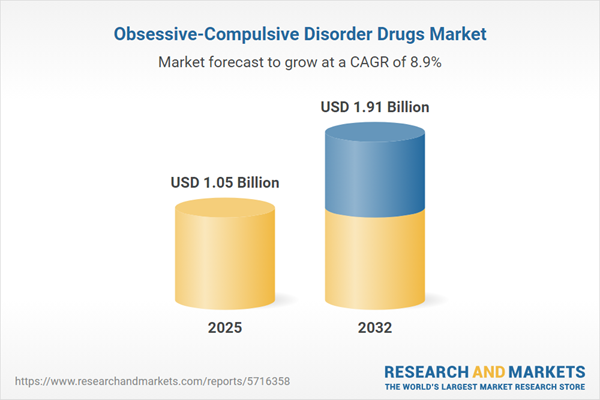Speak directly to the analyst to clarify any post sales queries you may have.
Senior decision-makers in pharmaceuticals and healthcare face a rapidly evolving landscape for obsessive-compulsive disorder drugs. This concise research supports C-suite strategic planning with applied, actionable insights at the intersection of clinical innovation, regulatory development, and shifting global supply strategies.
Market Snapshot: Obsessive-Compulsive Disorder Drugs Market Growth and Outlook
The obsessive-compulsive disorder drugs market is experiencing measurable expansion, moving from USD 969.71 million in 2024 to USD 1.05 billion in 2025 and expected to reach USD 1.91 billion by 2032. A compound annual growth rate (CAGR) of 8.89% demonstrates ongoing momentum, underpinned by elevated pharmaceutical innovation and increased adoption of personalized medicine practices. This growth is being strengthened further by changes in drug formulations, broader distribution channels, and greater focus on both adult and pediatric care. These industry patterns present opportunities and challenges, requiring companies to adapt to updated patient pathways, optimize supply chain efficiency, and respond to evolving therapeutic protocols. Understanding these dynamics is crucial for organizations seeking competitive differentiation within the obsessive-compulsive disorder drugs market.
Scope & Segmentation
- Drug Classes: Covers monoamine oxidase inhibitors, serotonin-norepinephrine reuptake inhibitors, selective serotonin reuptake inhibitors, and tricyclic antidepressants. Each class provides established solutions as well as new approaches for obsessive-compulsive disorder treatment.
- Distribution Channels: Hospital pharmacies, online pharmacies, and retail pharmacies influence patient access, compliance, and how providers manage therapy supply chains.
- Drug Types: Both branded and generic pharmaceutical options are included to showcase the balance between innovation-driven and cost-focused offerings impacting the market.
- Route of Administration: Considers oral and parenteral therapies, examining their relevance to treatment protocols, operational processes, and patient adherence in clinical use.
- End Users: Clinics, hospitals, and home care settings illustrate the significance of varied delivery models and their impact across multiple market environments.
- Patient Age Groups: Recognizes distinct needs in adult and pediatric populations, supporting the creation of age-appropriate therapeutic solutions.
- Geographical Coverage: Includes Americas, Europe, Middle East & Africa, and Asia-Pacific, each region offering unique regulatory, demographic, and supply chain variables for tailored strategy.
- Company Profiles Evaluated: Analyzes competitive positioning and growth drivers for Pfizer Inc., Eli Lilly and Company, GlaxoSmithKline plc, H. Lundbeck A/S, Teva Pharmaceutical Industries Ltd., Novartis AG, Sun Pharmaceutical Industries Ltd., Viatris Inc., Otsuka Pharmaceutical Co., Ltd., and Johnson & Johnson.
Key Takeaways for Decision-Makers
- Advancements in neurobiological research are driving the development of new therapeutics, supporting differentiation and refined market positioning.
- An expanding mix of branded and generic options is changing the dynamics for providers, payers, and patients, and influencing price competition.
- Personalized strategies are gaining importance as firms tailor development to individual patient profiles, specific age segments, and complex comorbidities.
- Distribution strategies spanning hospital, retail, and online channels are providing wider patient reach and streamlined access to care.
- Collaborations with biotechnology partners and academic institutions are fueling robust pipelines and shaping future product launches.
Tariff Impact: United States Supply Chain and Pricing Shifts
Adjustments in United States tariff policy are influencing global and domestic supply models. Pharmaceutical organizations are enhancing relationships with local suppliers and investing in nearshoring to strengthen sourcing resilience. This shift supports adaptation in online and retail supply chains, with hospital pharmacies central to cost management and access continuity. These initiatives help address disruption risks and improve assurance for market participants.
Methodology & Data Sources
This report utilizes a mixed-methods approach, incorporating expert interviews, peer-reviewed publications, supply chain analytics, and competitive benchmarking. Quantitative modeling and scenario-driven forecasting inform each projection, delivering sound insights for decision-makers navigating the obsessive-compulsive disorder drugs market.
Why This Report Matters
- Facilitates effective benchmarking in strategy development, innovation initiatives, and expansion planning within obsessive-compulsive disorder drug segments.
- Clarifies direct and indirect impacts of regulatory shifts, trade changes, and digital distribution on operational and leadership priorities.
- Enables data-based market entry, investment, and resource decisions that support long-term organizational value and resilience.
Conclusion
Accessing this market intelligence allows organizations to respond with agility to industry shifts. Enhanced strategy will support better patient outcomes and ongoing competitive positioning in the evolving global environment.
Additional Product Information:
- Purchase of this report includes 1 year online access with quarterly updates.
- This report can be updated on request. Please contact our Customer Experience team using the Ask a Question widget on our website.
Table of Contents
3. Executive Summary
4. Market Overview
7. Cumulative Impact of Artificial Intelligence 2025
List of Figures
Samples

LOADING...
Companies Mentioned
The key companies profiled in this Obsessive-Compulsive Disorder Drugs market report include:- Pfizer Inc.
- Eli Lilly and Company
- GlaxoSmithKline plc
- H. Lundbeck A/S
- Teva Pharmaceutical Industries Ltd.
- Novartis AG
- Sun Pharmaceutical Industries Ltd.
- Viatris Inc.
- Otsuka Pharmaceutical Co., Ltd.
- Johnson & Johnson
Table Information
| Report Attribute | Details |
|---|---|
| No. of Pages | 181 |
| Published | October 2025 |
| Forecast Period | 2025 - 2032 |
| Estimated Market Value ( USD | $ 1.05 Billion |
| Forecasted Market Value ( USD | $ 1.91 Billion |
| Compound Annual Growth Rate | 8.8% |
| Regions Covered | Global |
| No. of Companies Mentioned | 11 |









